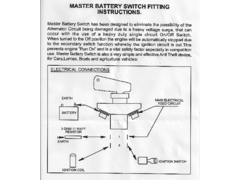
Fitting Battery Isolation Switch
Ivan - 10/12/12 at 10:57 AM
Hi - this might be dumb question but I need education so help would be appreciated.
I want to fit a battery isolation switch on the rear of my Cobra right next to where the battery is.
The battery has two single cables runnig to the front of the car - one +ve and one -ve. Now I was going to fit the switch on the -ve but a google
check says that I should run a line from the +ve of the alternator to the +ve battery terminal with a 100 amp fuse and then put the switch in the main
+ve line from the battery to the front.
Is there any specific reason why I can't just isolate the earth - surely if the earth is isolated then nothing can run or is that just showing my
lack of understanding - if so please educate me.
maccmike - 10/12/12 at 11:03 AM
Iv isolated my earth. In standard set up the earth connects the battery to the starter relay, Iv got neg to switch and then back to starter relay.
Works a treat.
pewe - 10/12/12 at 11:17 AM
IIRC the reason not to isolate the alternator is because if the isolation switch is turned off with the engine running it will cook the alternator.
On my electronic engineering son's advice I put a ballast resistor in series to avoid that situation.
linky
Also are you doing it for competition or peace of mind/anti-theft?
Mine is the later but allows the hazard lights to still function - so not isolating completely.
HTH.
Cheers, Pewe10 
minitici - 10/12/12 at 11:37 AM
The isolator should break the connection to the positive terminal of the battery not the chassis connection.
You should use the FIA type isolator with the dump resistor wired to the secondary contacts as per the attached instruction sheet:


FIA Battery Master wiring
The Black Flash - 17/12/12 at 01:59 PM
quote:
Originally posted by pewe
IIRC the reason not to isolate the alternator is because if the isolation switch is turned off with the engine running it will cook the alternator.
On my electronic engineering son's advice I put a ballast resistor in series to avoid that situation.
That's my understanding - you cut the power, but the alternator still turns for some time, and the power it's producing has no-where to go.
The ballast resistor gives it somewhere to dump that load for the second or so it takes the engine to stop.
However, if it's just a switch in the boot, and you'll never do it when the engine is running, it shouldn't matter AIUI.
steve m - 17/12/12 at 03:48 PM
I would agree, that the switch can be on either, in this application



